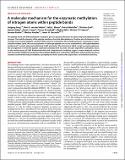Files in this item
A molecular mechanism for the enzymatic methylation of nitrogen atoms within peptide bonds
Item metadata
| dc.contributor.author | Song, Haigang | |
| dc.contributor.author | Van Der Velden, Niels S. | |
| dc.contributor.author | Shirran, Sally L. | |
| dc.contributor.author | Bleiziffer, Patrick | |
| dc.contributor.author | Zach, Christina | |
| dc.contributor.author | Sieber, Ramon | |
| dc.contributor.author | Imani, Aman S. | |
| dc.contributor.author | Krausbeck, Florian | |
| dc.contributor.author | Aebi, Markus | |
| dc.contributor.author | Freeman, Michael F. | |
| dc.contributor.author | Riniker, Sereina | |
| dc.contributor.author | Künzler, Markus | |
| dc.contributor.author | Naismith, James H. | |
| dc.date.accessioned | 2018-09-06T14:30:07Z | |
| dc.date.available | 2018-09-06T14:30:07Z | |
| dc.date.issued | 2018-08-24 | |
| dc.identifier | 255749519 | |
| dc.identifier | 2ca602dd-9046-4bab-a98d-ea91476d37de | |
| dc.identifier | 85052239215 | |
| dc.identifier | 000443498100048 | |
| dc.identifier.citation | Song , H , Van Der Velden , N S , Shirran , S L , Bleiziffer , P , Zach , C , Sieber , R , Imani , A S , Krausbeck , F , Aebi , M , Freeman , M F , Riniker , S , Künzler , M & Naismith , J H 2018 , ' A molecular mechanism for the enzymatic methylation of nitrogen atoms within peptide bonds ' , Science Advances , vol. 4 , no. 8 , eaat2720 . https://doi.org/10.1126/sciadv.aat2720 | en |
| dc.identifier.issn | 2375-2548 | |
| dc.identifier.other | ORCID: /0000-0003-3516-3507/work/48131842 | |
| dc.identifier.uri | https://hdl.handle.net/10023/15982 | |
| dc.description | This work was financially supported by ETH Zürich, University of Minnesota, the Swiss National Science Foundation (grant nos. 31003A_149512 and 200021–159713), Wellcome Trust (094476/Z/10/Z), ERC (NCB-TNT 339367), and BBSRC (BB/R018189/1). | en |
| dc.description.abstract | The peptide bond, the defining feature of proteins, governs peptide chemistry by abolishing nucleophilicity of the nitrogen. This and the planarity of the peptide bond arise from the delocalization of the lone pair of electrons on the nitrogen atom into the adjacent carbonyl. While chemical methylation of an amide bond uses a strong base to generate the imidate, OphA, the precursor protein of the fungal peptide macrocycle omphalotin A, self-hypermethylates amides at pH 7 using S-adenosyl methionine (SAM) as cofactor. The structure of OphA reveals a complex catenane-like arrangement in which the peptide substrate is clamped with its amide nitrogen aligned for nucleophilic attack on the methyl group of SAM. Biochemical data and computational modeling suggest a base-catalyzed reaction with the protein stabilizing the reaction intermediate. Backbone N-methylation of peptides enhances their protease resistance and membrane permeability, a property that holds promise for applications to medicinal chemistry. | |
| dc.format.extent | 13 | |
| dc.format.extent | 2746650 | |
| dc.language.iso | eng | |
| dc.relation.ispartof | Science Advances | en |
| dc.subject | QH301 Biology | en |
| dc.subject | NDAS | en |
| dc.subject.lcc | QH301 | en |
| dc.title | A molecular mechanism for the enzymatic methylation of nitrogen atoms within peptide bonds | en |
| dc.type | Journal article | en |
| dc.contributor.sponsor | The Wellcome Trust | en |
| dc.contributor.sponsor | European Research Council | en |
| dc.contributor.institution | University of St Andrews. Biomedical Sciences Research Complex | en |
| dc.contributor.institution | University of St Andrews. School of Biology | en |
| dc.identifier.doi | https://doi.org/10.1126/sciadv.aat2720 | |
| dc.description.status | Peer reviewed | en |
| dc.identifier.grantnumber | 094476/Z/10/Z | en |
| dc.identifier.grantnumber | NCB-TNT | en |
This item appears in the following Collection(s)
Items in the St Andrews Research Repository are protected by copyright, with all rights reserved, unless otherwise indicated.

